ESP AUDI A8 2016 Repair Manual
[x] Cancel search | Manufacturer: AUDI, Model Year: 2016, Model line: A8, Model: AUDI A8 2016Pages: 302, PDF Size: 75.68 MB
Page 194 of 302

Smart Technology
Switching on and off
ESC turns on automatically when you start the engine.
Fig. 186 Center console w it h ESC O FF but ton
ESC level s
Sport mode on
The following situations are exceptions where it
may be useful to switch on sport mode to allow
the wheels to spin:
- Rocking the vehicle to free it when it is stuck
- Driving in deep snow or on loose ground
- Dr iving with snow chains
Sport mode off
Behavior
The ESC and ASR stabilization functions The full stabilization function of the ESC
are limited ¢
A:,.. and ASR is ava ilable again .
Operation Press the 00 button. Press
the[!] button again.
Indicator II turns on. II turns off .
lights
Driver mes- Stabilization control (ESC): Sport Warn- Stabilization control (ESC): On
sages ing! Reduced stability
A WARNING
You should only switch sport mode on if your
dr iv ing abilities and road condit ions perm it .
- The stabilization function is limited when
sport mode is sw itched on. The driving
wheels cou ld spin and the vehicle could
swerve, espec ially on s lick o r sli ppery road
s urfac es.
Sport mode cannot be sw itched on if t he
cruise cont rol system* or the adaptive cru ise
cont rol* is switched on.
Braking
What affects braking efficiency?
New brake pads
During the first 250 miles (400 km), new brake
pads do not possess the ir full braking effect, they
have to be "broken in" first ¢
.1:,.. The break-in pe
riod can be considerably longe r fo r vehicles with
192
ceramic brake rotors*. You can compensate for
this slightly reduced braking power by push ing
harder on the brake pedal. Avoid heavy braking
lo ads during the break-in period.
Operating conditions and driving habits
The brakes on today's automobiles are still sub
j ect to wear, depending large ly on operating con
ditions and driving habits¢,& . On vehicles that
are either driven mostly in stop-and-go city traf
fic or are driven hard, the brake pads should be
checked by your authorized Audi dealer more of
ten than specified in the
Warranty & Mainte
nance booklet .
Failure to have your brake pads
inspected can result in reduced brake perform
ance.
On steep slopes, you should use the brak ing ef
fect of the engine. T his way, you prevent unnec
essary wea r on the brake system. If you mus t use
your brakes, do not hold the brakes down contin-
u ously. Pump th e brakes at intervals. ..,.
Page 195 of 302

Operating noi se
Noises may occur when braki ng depend ing on the
speed, braking force and outside cond itions s uch
as temperature and humidity.
Due to the na ture of t he mate ria ls used in ce ram
ic bra ke rotors*, noises m ay become mo re appa
ren t at low speeds.
Effect of wat er and road salt
In ce rtain situat ions, for example after driving
through water, in heavy ra in, afte r ove rnig ht con
densat ion or after washing your car, the braking
effe ct can be red uced by moisture or ice on the
b rake rotors and brake pads. The brakes must be
dried first w ith a few careful brake applications .
At highe r speeds and with t he windsh ie ld wipers
turned o n, the bra ke pads p ress against the bra ke
rotors for a short amount of time . This occ urs at
regular intervals without the driver noticing and
provides for better bra ke response time under
wet conditions.
The effectiveness of the brakes can be reduced
when the vehicle is dr iven on a salt-covered road
and the brakes are not used. L ikewise, you clean
off accumu lated salt coat ing from brake discs
and pads with a few cautious applications of the
brake
c::> ,& .
Due to their sur face characteristics, ceramic
brake rotors* absorb mo isture in such condit ions.
This can cause a temporary reduction in braking
force compared to dry brakes. You can compen
sate for this by pressing the brake peda l harder.
Cor rosion
There may be a tendency for dirt to b uild up on
the brake pads and corros ion to form on the discs
if the car is not driven regularly or only for short
tr ips with little use of the brakes.
If the brakes are not used frequently, or if corro
sion has formed on the discs, it is adv isable to
clean off the pads and discs by brak ing firmly a
few t imes from a moderately high speed
c::> ,& .
Sma rt Technology
Faults in the brake system
If you s hou ld notice a sudden increase in br ake
peda l travel, then one of the two bra ke circu its
may have fai led
c::> ,& .
Low brake fluid level
Malfunctions ca n occu r in the brake system if the
brake fluid level is too low . T he brake flu id leve l
is monitored elect ronically.
Brake boost er
The brake booster works w ith vacuum pressure
wh ich is created only when the engine is runn ing
c::> ,& .
Brake lining wear status
Brake lining wear may be checked by visua l in
spect ion of the cond ition of the brake pads
t hr ough the openings in the wheel. If necessary,
the wheel may be removed for t his inspection
c::> page 259, Replacing wheels .
.8_ WARNING
-New b rake p ads don't h ave the bes t stop
p ing power an d must be "broken-in" during
the initial 250 miles (400 km) . The break-in
pe riod can be considerably longer for
veh icles with ceramic brake rotors*. You can
compensate for this by pressing the brake
pedal more firmly. This also applies late r
when new pads are installed.
- You shou ld perform braking maneuvers for
the purpose of cleaning the brake system only i f road co ndit ions pe rmit . Other road
users m ust not be put at r is k -you may
cause an ac cident!
- Before descending a steep g rade, reduce
speed and sh ift transmission into a lower
gear o r lower dr iving range. Do not r ide the
b ra kes or hold the pe dal down too long or
too often. This cou ld cause the b rakes to ge t
hot and dimin ish b raking effic iency .
- Do not " ride the bra kes" by rest ing you r foot
on the pedal when you do no t intend to
brake. This may cause the brakes to over
heat, premature wear and increased stop
p ing distance.
193
Page 198 of 302
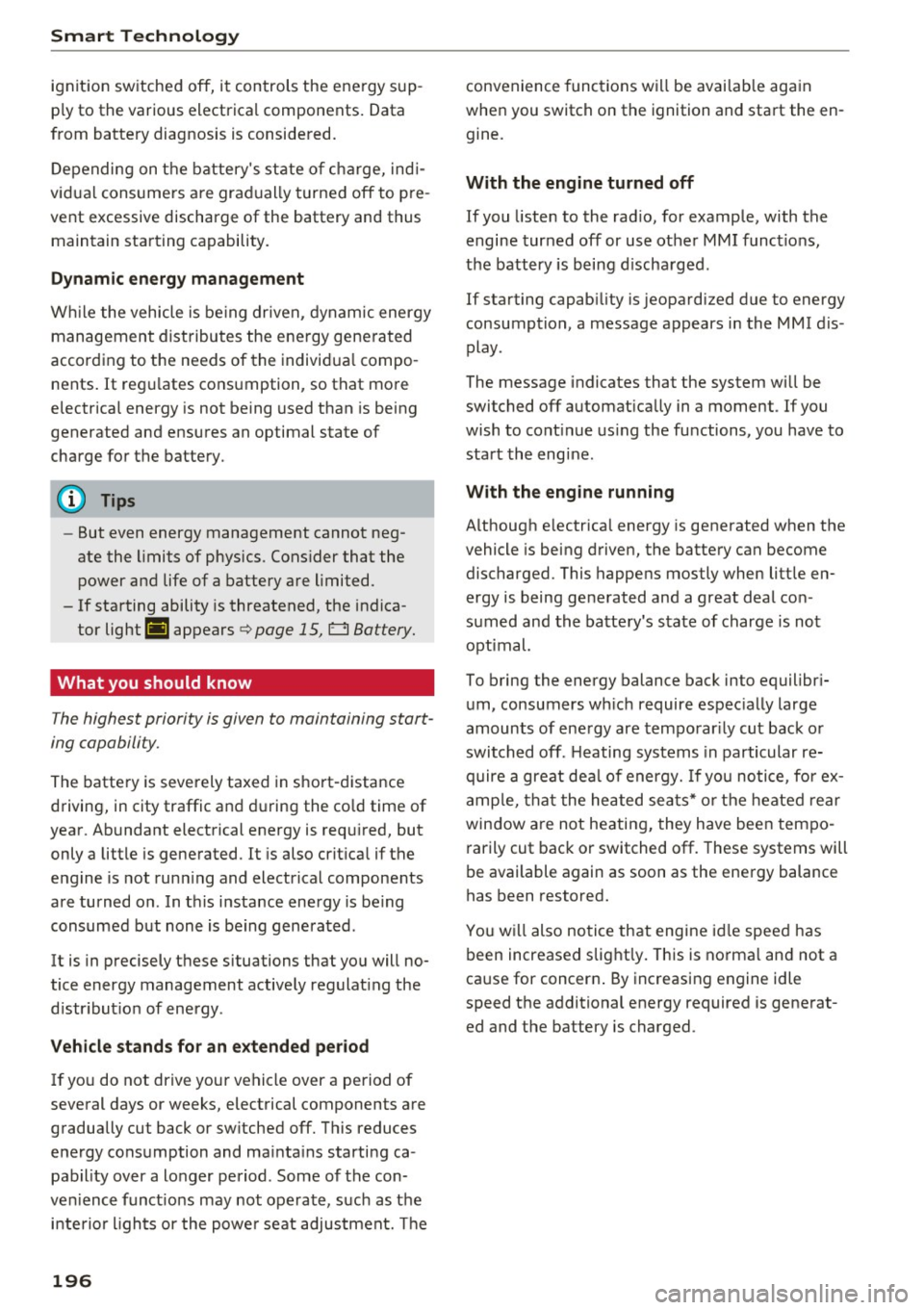
Smart Technology
ignition switched off, it controls the energy sup
p ly to the various electrical components. Data
from battery diagnosis is considered.
Depending on the battery's state of charge, indi
vidual consumers are gradually turned off to pre
vent excessive discharge of the battery and thus maintain starting capability.
Dynamic energy management
While the vehicle is being driven, dynamic energy
management distributes the energy generated
according to the needs of the individual compo
nents.
It regu lates consumption, so that more
electrical energy is not being used than is being
generated and ensures an optimal state of
charge for the battery.
(D Tips
- But even energy management cannot neg
ate the limits of physics . Cons ider that the
power and life of a battery are limited.
- If starting ability is threatened, the indica
tor light (•) appears
9 page 15, Cl Battery.
What you should know
The highest priority is given to maintaining start
ing capability .
The battery is severely taxed in short-distance
driving, in city traffic and during the cold time of
year. Abundant electrical energy is required, but
only a little is generated . It is also crit ica l if the
engine is not running and electrical components
are turned on . In this instance energy is be ing
consumed but none is being generated .
It is in precisely these situations that you will no
tice energy management actively regulat ing the
d istr ibut ion of energy .
Vehicle stands for an extended period
If you do not driv e your vehicle over a period of
several days or weeks, electrical components are
gradually cut back or switched off. This reduces
energy consumption and ma inta ins starting ca
pability over a longer period . Some of the con
ven ience funct ions may not operate, such as the
interior l ights or the power seat adjustment. The
196
convenience functions will be availab le again
when you switch on the ignition and start the en gine.
With the engine turned off
If you listen to the radio, for example, with the
engine turned off or use other MMI funct ions,
the battery is being d ischarged .
If starting capab ility is jeopardized due to energy
consumption, a message appears in the MMI dis
play .
The message indicates that the system will be
switched off automat ically in a moment . If you
wish to cont inue using the functions, you have to
start the engine.
With the engine running
Although electrica l energy is generated when the
vehicle is being driven, the battery can become
discharged. This happens mostly when little en
ergy is being generated and a great deal con
sumed and the battery's state of charge is not
opt imal.
To bring the energy balance back into equilibr i
um, consumers wh ich require espec ially large
amounts of energy are temporarily cut back or
switched off. Heating systems in particular re
quire a great dea l of energy. If you notice , fo r ex
amp le, that the heated seats* or the heated rear
window are not heating, they have been tempo
rarily cut back or switched off. These systems will
be available aga in as soon as the energy balance
has been restored.
You will also notice that engine idle speed has
been increased slig htly. This is norma l and not a
cause for concern . By increasing engine idle
speed the additional energy required is generat
ed and the battery is charged.
Page 199 of 302
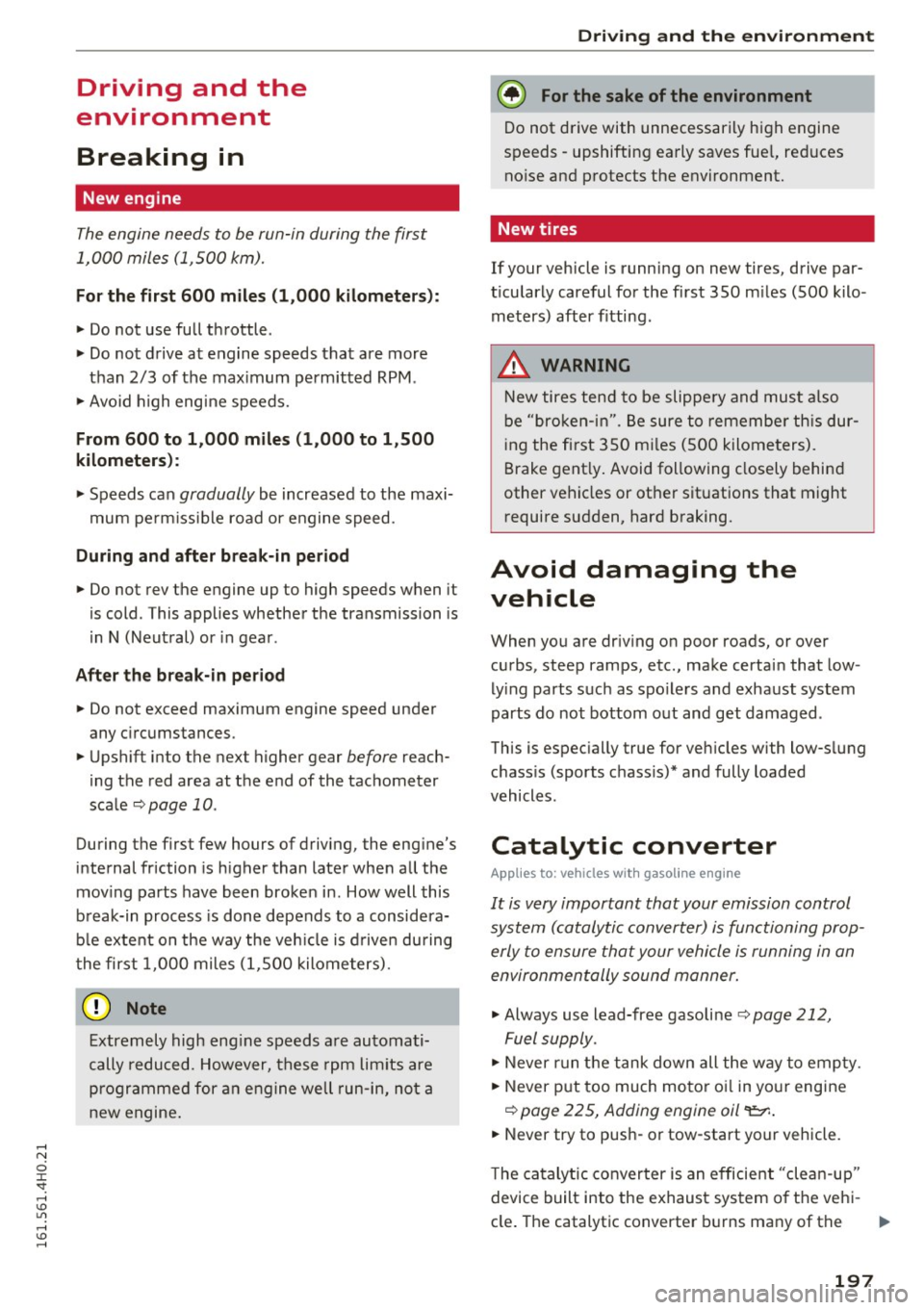
Driving and the
environment
Breaking in
New eng ine
The engine needs to be run-in during the first
1,000 miles (1 ,500 km).
For the first 600 miles (1 ,000 kilometers):
"' Do not use full throttle .
"' Do not drive at engine speeds that are more
than 2/3 of the max imum permitted RPM .
"' Avoid high eng ine speeds.
From 600 to 1 ,000 miles (1,000 to 1,500
kilometers ):
"' Speeds can gradually be increased to the maxi
mum pe rm issib le road or e ngine speed.
During and after b reak-in period
"' Do not rev the engine up to high speeds when it
is cold . This applies whether the transmission is
in N (Neutral) or in gear .
After the bre ak-in period
"' Do not exceed maximum engine speed under
any circumstances .
"' Upshift into the nex t higher gear
before reach
ing the red area at the end of the tachometer
sca le
c:::;, page 10.
During the first few hours of driving , the eng ine's
internal friction is higher than later when all the
mov ing parts have been broke n in. How well this
b reak-in process is done depends to a considera
b le exte nt o n the way the veh icle is d rive n du ring
the first 1,0 00 miles (1,500 kilome ters).
(D Note
E xtremely high eng ine speeds a re au toma ti
cally reduced. However, t hese rpm li mits are
p rogr amme d fo r an eng ine well run-in, not a
new engine .
Driving and the envir onment
{® For the sake of the environment
Do not drive with unnecessarily high engine
spe eds -upshifting early saves fuel, red uces
no ise and protects the environment.
New tires
If your vehicle is runni ng on new tires, drive par
t icularly careful for the first 3S0 m iles (500 kilo
meters) after fitting .
_&. WARNING
New tires tend to be slippe ry and mus t also
b e "bro ken- in". Be sure to remembe r th is dur
i ng the first 350 m iles ( 500 k ilome ters).
Brake gent ly . Avoid following closely behin d
other vehicles or other s ituations that might
require sudden, hard braking.
Avoid damaging the
vehicle
When you are dr iv ing on poor roads, or over
curbs, steep ramps, etc., make certai n that low
ly ing parts such as spo ile rs and exhaust system
parts do not bottom o ut and get damaged .
This is espec ially true for veh icles with low-s lung
chass is (sports c hass is)* and fully loaded
vehicles .
Catalytic converter
Applies to: vehicles with gasoline engine
It is very important that your emission control
system (catalytic converter) is functioning prop
erly to ensure that y our vehicle is running in an
environmen tally sound manner.
"' Always use lead-free gasoline c:::;, page 212,
F uel supply .
"' Never run t he tank down all the way to emp ty.
"' Never put too much motor o il in yo ur engine
c:::;, page 225, Adding engine oil ce:r..
"' Never try to push- or tow-start your vehicle.
T he ca talytic co nverter is an efficient "cle an-up"
device built into the exhaust sys tem o f th e vehi -
-
cle. The catalytic converter b urns many of the .,.
197
Page 202 of 302

Driving and th e en vironm ent
Avoid full throttle
Driving at moderate speeds saves fuel and im
proves your mileage .
.,. Try and keep well below your car's maximum
speed .
Accelerating gent ly reduces fue l consumption,
engine wear, and does not disturb the environ ment.
Fue l consumption, exhaust emissions and engine
noise increase d isproportionately at high speeds.
If you drive at approximately three quarters of
top speed, fuel consumption will be reduced by
one half. Never drive faster than the posted
speed limit and weather conditions permit.
Reducing unnecessary idling
Even when your car is just idling it burns up fuel.
.,. Shut the engine off when you are not driv ing
the vehicle.
.,. Do not warm up the vehicle by letting the en-
gine run at idle .
The idling phase is automatically reduced for
veh icles with the Start-Stop-System*. It is effi
cient to switch off the eng ine in vehicles without
the Start -Stop -System when stopped at ra ilroad
crossings and long red lights . Turning the engine
off for just 30-40 seconds saves more fuel than is bu rned by starting the engine aga in.
It takes a long t ime for the engine to warm up
fu lly when it is running at idle . However, wear
and noxio us em iss ions are espec ially high when
the engine is wa rm ing up. So you sho uld drive
away as soon as you start the engine a nd avoid
running at high rpms while the engine is still
warming up.
(D Note
Do not leave engine idling unattended a fter
starting . If warn ing lights should come on to
indicate improper operation, they wou ld go
unheeded. Extended idling a lso produces
heat, wh ich co uld result in overheat ing or
200
other damage to the vehicle or othe r proper
ty.
Regular maintenance
A badly tuned engine unnecessarily wastes a lot of fuel.
.,. Have you r veh icle serviced at regula r interva ls.
By hav ing your veh icle regularly serv iced by an
Audi dealer he lps to ensure that it runs p roperly
and e conomi cally. The cond ition of you r vehicle
not only affects its safety and ab ility to hold its
val ue, it also affects
fuel con sumption .
Check your oil each t ime you fill your tank .
The amount of oi l used is related to engine load
and speed .
It is normal for the oil consumption of a new en
gine to reach its lowest value after a certain mile
age has been driven .
You must drive your vehicle about 3,000 mi les
(5,000 kilometers) before you can properly as
sess oil consumpt ion.
This also app lies to fue l consumption and engine
output .
(D Note
-Have your ve hicle ma intained properly and
in accordance with the se rvice recommenda
tions in your Warranty
& M aintenance book
let. Lack of proper maintenance as we ll as
improper use of the veh icle w ill impair the
function of the em ission control system and
cou ld lead to damage .
- Do not alter or remove any component of
the Emission Contro l System u nless ap
proved by the man ufacturer.
- Do not alter or remove any device, such as
heat shields, switches, ign ition w ires,
valves, which are designed to protect your
vehicle's Emission Contro l System and other
impo rtant ve hicle compone nts.
Page 205 of 302

Trailer load distribution
Be sure the load in the trailer is held securely in
p la ce to prevent it from sh ifting forward, back
ward or sideways.
Never allow a passenger to ride in a trailer¢.&.
in Driving instructions on page 204.
Engine cooling system
Towing a trailer makes the engine work harder . It
is important that the cool ing system's perform
ance is up to the addit ional load. Make sure that
the cooling system has enough fluid.
Tire pressure
When towing a trailer, inflate the tires of your
veh icle to the cold tire pressure listed under "Full
load " on the label located on the driver's side B
pillar (vis ible when the door is open). Inflate
trailer tires to trailer and tire manufacturers'
specif ications.
Lights
Check to make sure both vehicle and trailer lights
are working proper ly.
Safety chains
Be sure trailer safety chains are properly connect
ed from the trailer to the hitch on the vehicle.
Leave enough slack in the chains to permit turn
in g corners . When you install safety cha ins, make
sure they wi ll not drag on the road when you are
driving.
The chains should cross under the trailer tongue
to prevent it from dropping in case of separat ion
from the hitch.
Adjusting the Audi drive select
Make sure the vehicle is on a level surface before
hitching up the trailer and before adjusting the
tongue we ight. The vehicle must be in
auto or
comfort driving mode and not ra ised
¢ page 106, 9Q) .
Make sure that the vehicle is lowered. In Info
tainment, select:
I CARI function button > lower
control button .
Trailer mode
If you must drive under poor road conditions, you
can raise the vehicle
after coupling the trailer or
after adjusting the tongue weight¢ page 108.
(D Note
-Changes in temperature or load can affect
the height of the vehicle.
- Always select auto or comfort mode. Other
w ise, the tong ue load specified for your ve
hicle will no longer be applicable .
Driving instructions
Driving with a trailer always requires extra care
and consideration.
T o obtain the best possible handling of veh icle
and trailer, p lease note the following:
.,. Do not tow a loaded trailer when your car itself
is not loaded.
.,. Be especially careful when passing other
vehicles.
.,. Observe speed limits.
.,. Do not drive at the maximum permissible
speed .
.,. Always apply brakes early.
.,. Monitor the temperature gauge.
Weight distribution
Towing a loaded tra iler with an empty car results
in a highly unstab le distribution of weight . If this
cannot be avoided, drive at very low speeds only
to avoid the risk of losing steering control.
A "balanced" rig is easier to operate and control.
This means that the tow vehicle shou ld be loaded
to the extent possib le and permissib le, while
keeping the trailer as light as possible under the
cir cumstances . Whenever poss ible, transfer
some cargo to the luggage compartment of the
tow veh icle while observing tongue load require
ments and vehicle load ing conside rations.
Speed
The higher the speed, the more difficult it be
comes for the driver to control the r ig. Do not
drive at the maximum permissible speed. Reduce
your speed even more if load, weather or wind .,._
203
Page 206 of 302
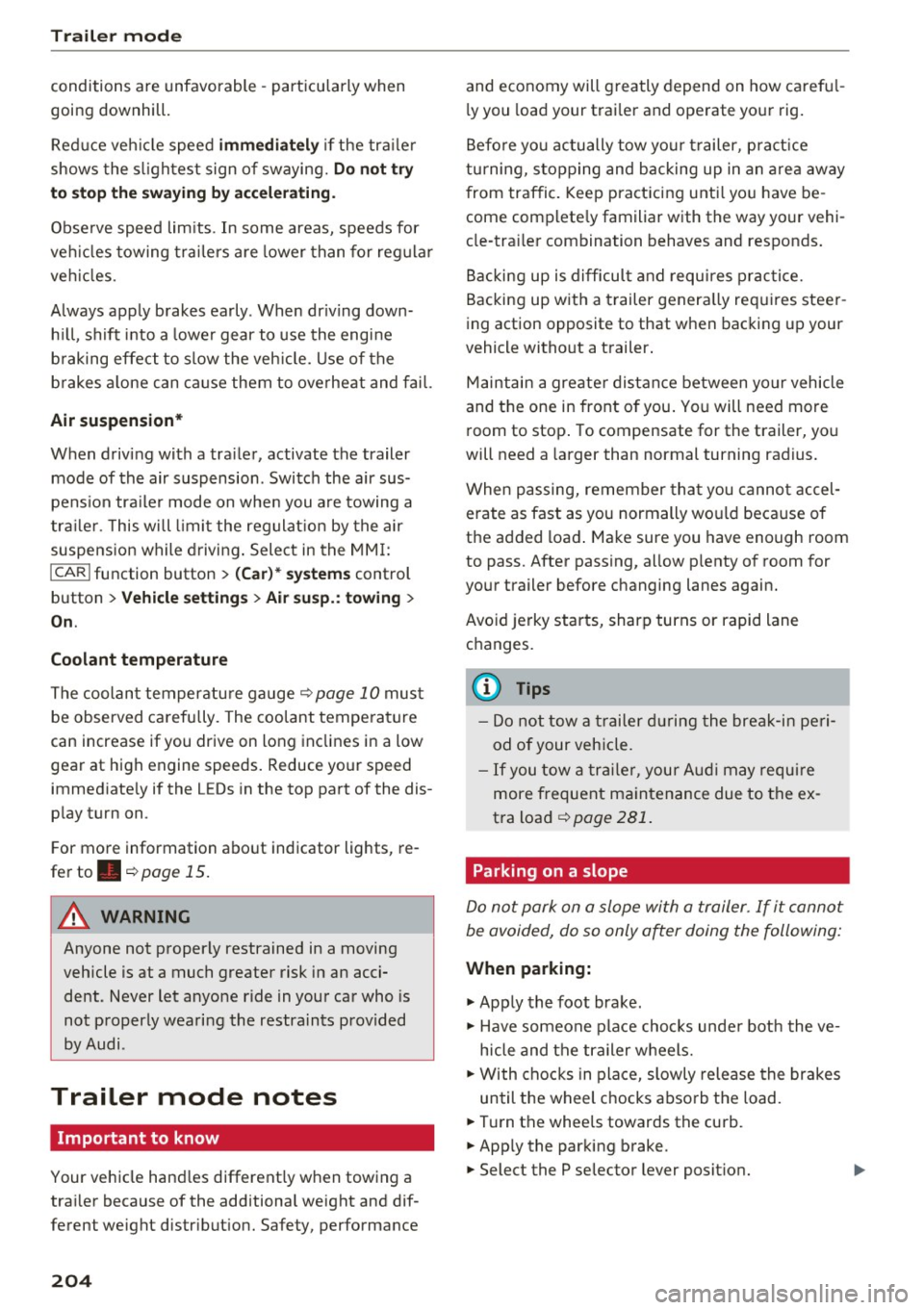
Trailer mod e
conditions are unfavorable - particularly when
going downhill.
Red uce veh icle speed
imm ediatel y if the tra ile r
shows the s lightest sign of swaying.
Do not try
to stop the sway in g b y accele rating .
Observe speed lim its . In some areas, speeds for
ve hicl es towing tra ilers are lower than for reg ula r
veh icles.
A lways apply brakes early . When dr iving down
h ill , sh ift into a lower gear to use the engine
b raking effect to slow the veh icle. Use of the
brakes a lone can cause them to overheat and fail.
Air suspension*
When driving with a tra iler, activate the trailer
mode of the air suspension . Switch the air sus
pens ion tra iler mode on when you a re towing a
tra ile r. This will limit the regulat ion by the air
suspens ion while driving . Select in the MM I:
ICARI function button > (Car )* sys tem s control
button >
Vehicle setting s > Air su sp .: to wi ng >
On .
Coolant temperature
The coolan t temperature gauge¢ page 10 must
be observed carefully. The coo lant temperature
can increase if you drive on long inclines in a low
gear at high engine speeds. Reduce your speed
immed iate ly if the LEDs in the top part of the dis
p lay turn on.
For more information about indicator lights, re
fer to.
¢page 15.
A WARNING
Anyone not properly restrained in a moving
vehicle is at a much greater risk in an acci
dent. Never let anyone ride in your car who is
not properly wearing the restraints provided
by Audi.
Trailer mode notes
Important to know
Your vehicle hand les different ly when towing a
trai ler because of the additiona l weight and dif
ferent weight distr ibut ion. Safety, performance
204
-
and economy will g reatly depend on how carefu l
l y you load your trai ler and operate your rig .
Befo re yo u actually tow yo ur t railer, pract ice
turning, stopping and backing up in an area away
from traffic. Keep practicing unti l you have be
come complete ly familiar with the way your vehi
cle-tra iler combination behaves and responds .
Backing up is diff icult and requ ires practice.
Backing up with a trailer genera lly req uires steer
ing action opposite to that when backing up your
vehicle witho ut a trailer .
Maintain a greater distance between yo ur vehicle
and the one in front of you. You will need more
room to stop . To compensate for the trailer, you
will need a larger than normal turning radius .
When passing, remember tha t you canno t accel
erate as fast as you normally wou ld because of
the added load . Make sure you have enough room
to pass. After passing, allow p lenty of room for
your trailer before changing lanes again.
Avoid jerky starts, sharp turns or rapid lane changes.
(D Tips
- Do not tow a trailer du ring the break-i n pe ri
od of your vehicle.
- If you tow a tr aile r, your A udi may requi re
more frequent ma intenance due to the ex
tra load ¢
page 281.
Parking on a slope
Do not park on a slope with a trailer . If it cannot
be avoided, do so only after doing the following:
When parking:
.,. App ly the foot brake.
.,. Have someone p lace chocks unde r both the ve
hicle and the trailer wheels .
.,. With chocks in place, slowly release the brakes
until the wheel chocks abso rb the load .
.,. Turn the whee ls towards the curb.
.,. App ly the parking brake .
.,. Select the P selector lever posit ion.
Page 208 of 302
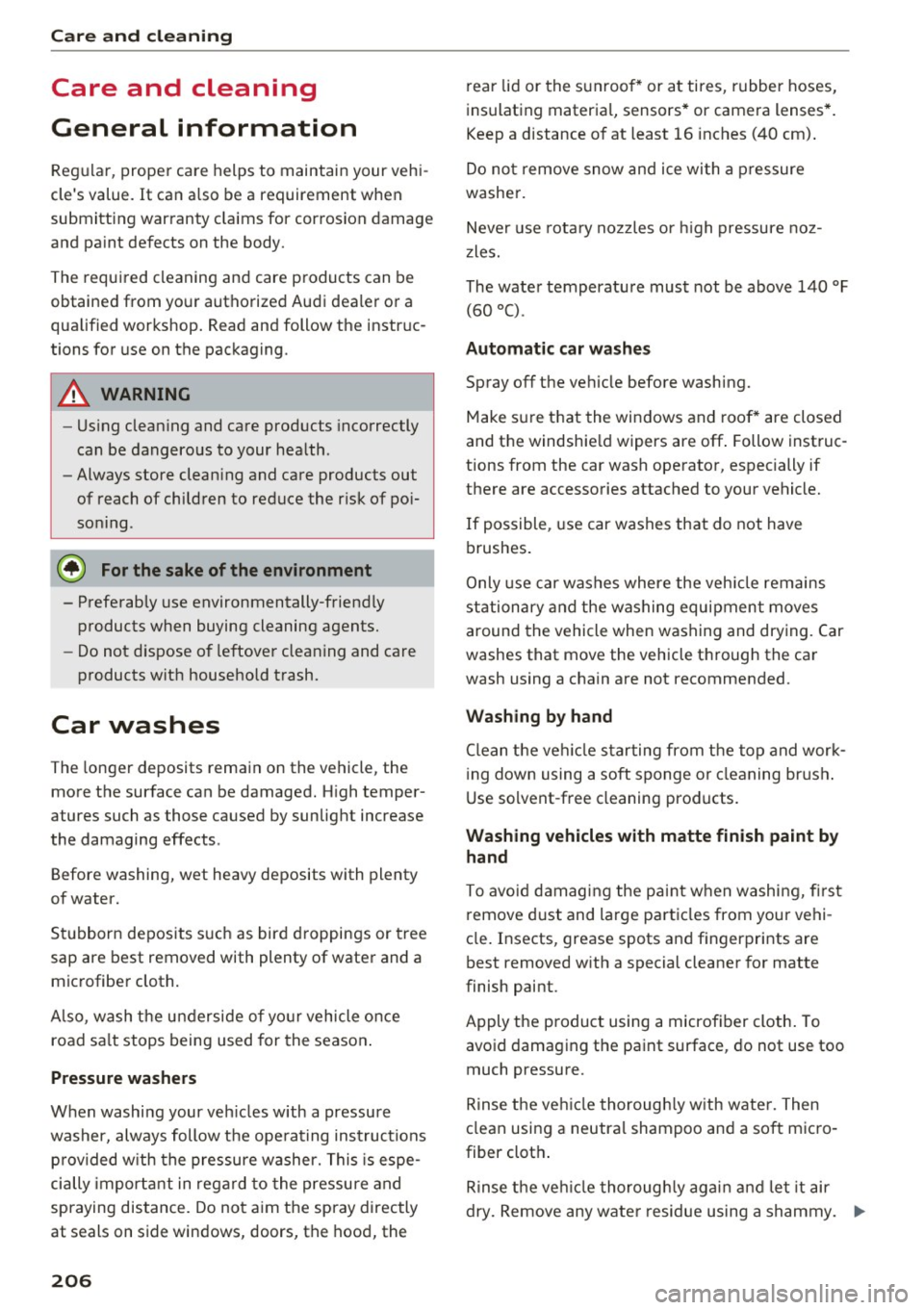
Care and cleaning
Care and cleaning
General information
Regular, proper care helps to maintain your vehi
cle's value.
It can also be a requirement when
submitting warranty claims for corrosion damage
and paint defects on the body.
The required cleaning and care products can be
obtained from your authorized Audi dealer or a
qualified workshop. Read and follow the instruc
tions for use on the packaging.
A WARNING
-Using cleaning and care products incorrectly
can be dangerous to your health .
- Always store cleaning and care products out
of reach of children to reduce the risk of poi
soning.
@ For the sake of the environment
- Preferably use environmentally-friendly
products when buying cleaning agents.
- Do not dispose of leftover cleaning and care
products with household trash.
Car washes
The longer deposits remain on the vehicle, the
more the surface can be damaged. High temper
atures such as those caused by sunlight increase
the damaging effects .
Before washing, wet heavy deposits with plenty
of water.
Stubborn deposits such as bird droppings or tree
sap are best removed with plenty of water and a
microfiber cloth.
Also, wash the underside of your vehicle once
road salt stops being used for the season.
Pressure washers
When washing your vehicles with a pressure
washer, always follow the operating instructions
provided with the pressure washer. This is espe
cially important in regard to the pressure and
spraying distance . Do not aim the spray directly
at seals on side windows, doors, the hood, the
206
rear lid or the sunroof* or at tires, rubber hoses,
insulating material, sensors* or camera lenses*.
Keep a distance of at least 16 inches (40 cm) .
Do not remove snow and ice with a pressure
washer.
Never use rotary nozzles or high pressure noz
zles.
The water temperature must not be above 140 °F
(60 °C).
Automatic car washes
Spray off the vehicle before washing.
Make sure that the windows and roof* are closed
and the windshield wipers are
off . Follow instruc
tions from the car wash operator, especially if
there are accessories attached to your vehicle.
If possible, use car washes that do not have
brushes.
Only use car washes where the vehicle remains
stationary and the washing equipment moves
around the vehicle when washing and drying. Car
washes that move the vehicle through the car
wash using a chain are not recommended.
Washing by hand
Clean the vehicle starting from the top and work
ing down using a soft sponge or cleaning brush.
Use solvent-free cleaning products.
Washing vehicles with matte finish paint by
hand
To avoid damaging the paint when washing, first
remove dust and large particles from your vehi
cle. Insects, grease spots and fingerprints are
best removed with a special cleaner for matte
finish paint.
Apply the product using a microfiber cloth. To
avoid damaging the paint surface, do not use too
much pressure.
Rinse the vehicle thoroughly with water. Then
clean using a neutral shampoo and a soft micro
fiber cloth .
Rinse the vehicle thoroughly again and let it air
dry. Remove any water residue using a sham my. ..,..
Page 210 of 302
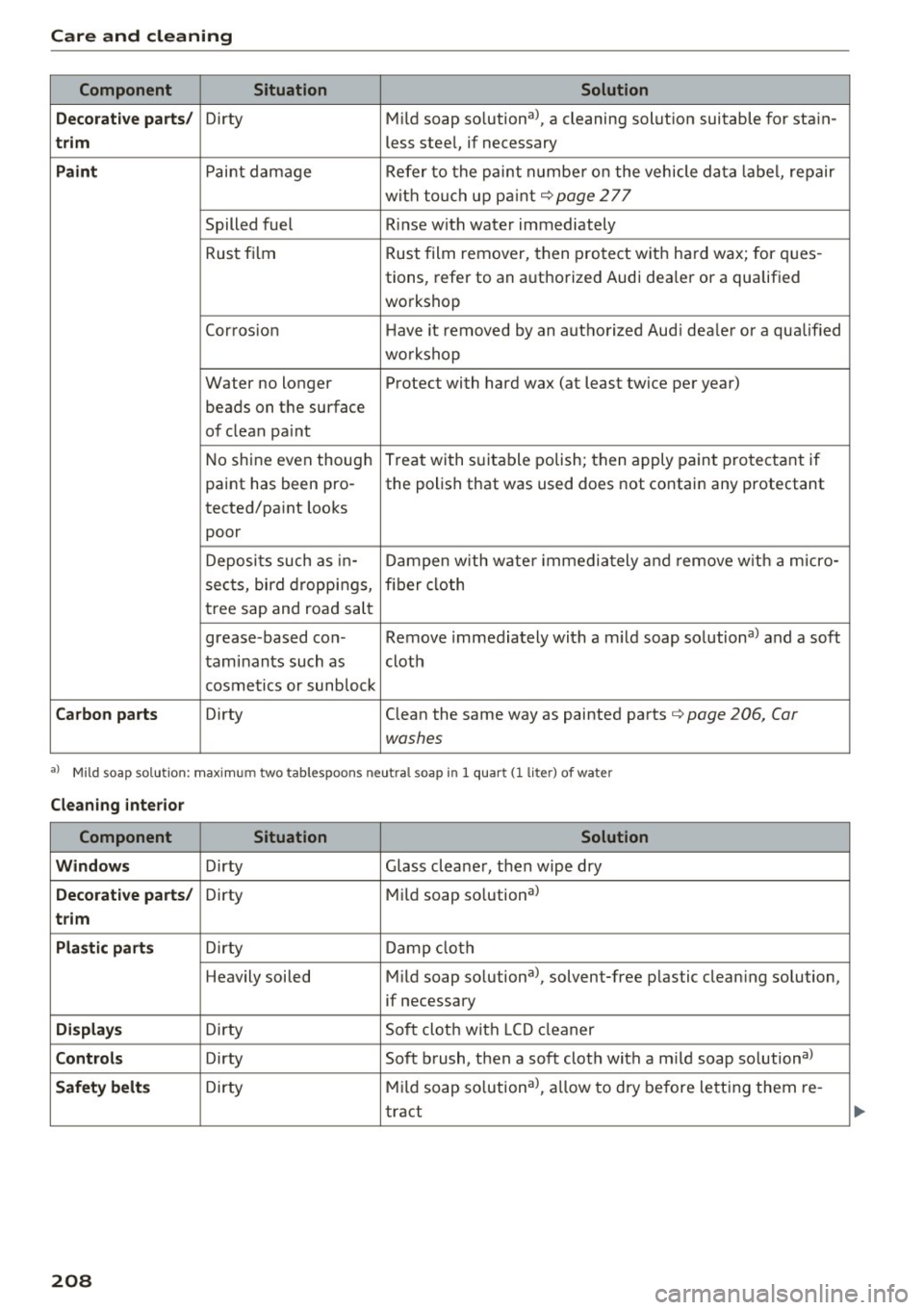
Care and cleaning Component Situation Solution
Decorative parts/
Dirty Mild soap solutiona>, a cleaning solution suitable for stain-
trim less steel, if necessary
Paint Paint damage Refer to the paint number on the vehicle data label, repair
with touch up paint
¢page 277
Spilled fuel Rinse with water immediately
Rust film Rust film remover, then protect
with hard wax; for ques-
tions, refer to an authorized Audi dealer or a qualified
workshop
Corros ion Have it removed by an authorized Aud i dea ler or a qua lified
wo rkshop
Water no longer Protect with hard wax (at least twice per year)
beads on the surface
of clean pa int
No shine even though Treat with suitable polish; then apply paint protectant if
paint has been pro- the polish that was used does not contain any protectant
tected/paint looks
poor
Deposits such as in-Dampen with water immediately and remove w ith a micro-
sects, bird droppings, fiber cloth
tree sap and road salt
grease-based con- Remove immediately with a m ild soap solutiona> and a soft
taminants such as cloth
cosmetics or sunblock
Carbon parts Dirty Clean the same way as painted parts¢ page 206, Car
washes
a l Mild soap so lution: maxim um two tablespoo ns neu tra l soap in 1 quar t Cl lite r) of water
Cleaning interior
Component Situation Solution
Windows
Dirty Glass cleaner, then wipe dry
Decorative parts/ Dirty Mild soap so lutiona>
trim
Plastic parts
Dirty Damp cloth
Heavily soiled Mild soap solutiona>, solvent-free p lastic clean ing solution,
if necessary
Displays Dirty Soft cloth with LCD cleaner
Controls Dirty Soft brush, then a soft cloth with a m ild soap solutiona >
Safety belts Dirty Mild
soap solutiona>, allow to dry before letting them re-
tract
208
...
Page 211 of 302
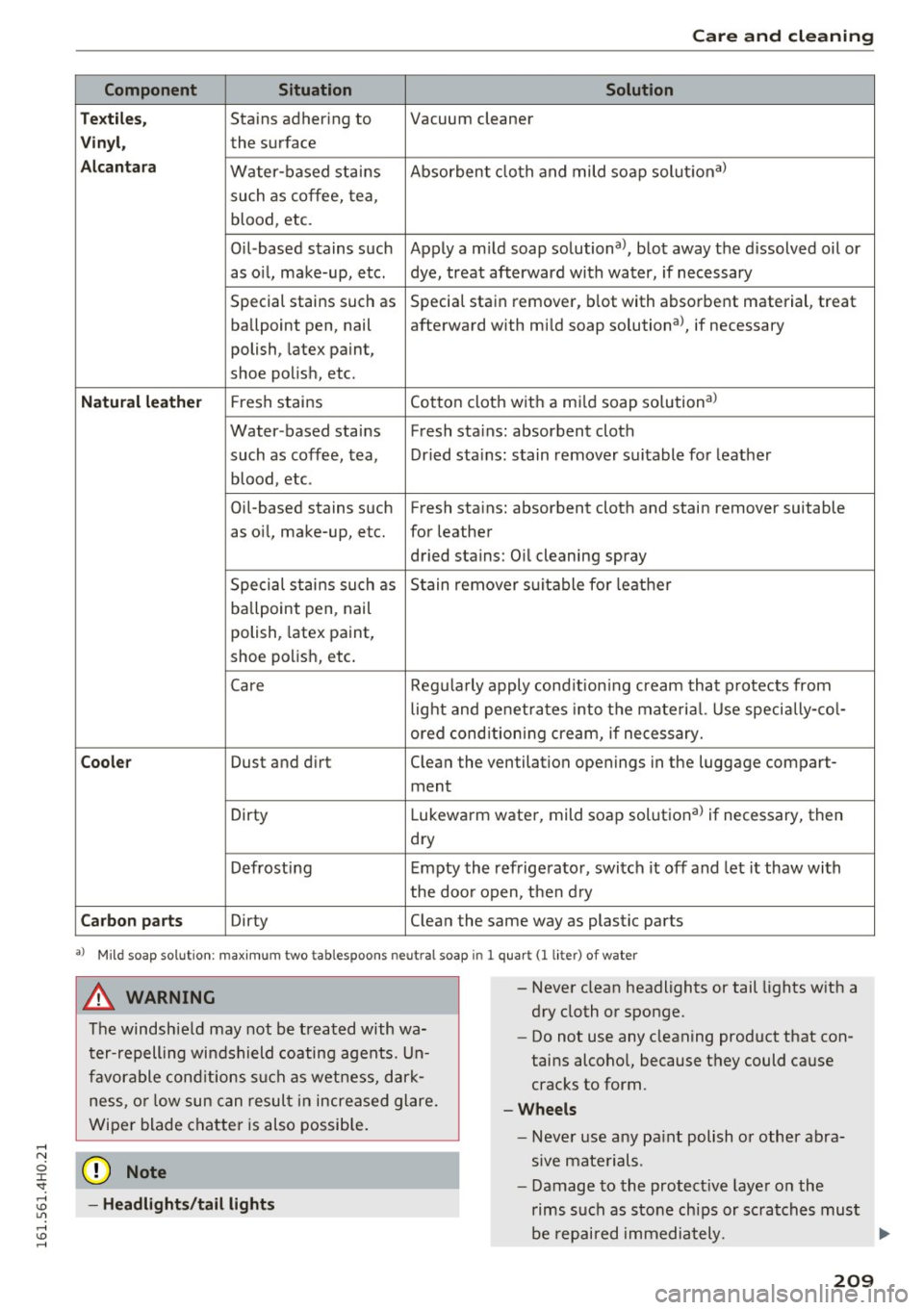
Care and cleaning
Component S ituation Solution
Tex tiles,
Stains adhering to Vacuum cleaner
Vin yl, the surface
A lcan tara Water-based stains Absorbent cloth and mild soap
solutional
such as coffee, tea,
blood, etc.
Oil-based stains such Apply a m ild soap solutional, blot away the d issolved oil or
as o il, make-up, etc. dye, treat afterward with water, if necessary
Special stains such as Special stain remover, blot with
absorbent material, treat
ballpoint pen, nail afterward with mild soap solutional, if necessary
polish, latex paint,
shoe polish, etc .
Natural le athe r Fresh stains Cotton cloth
with a mild soap solutiona l
Water -based stains Fresh stains : absorbent cloth
such as coffee, tea, Dried stains : stain remover suitable for leather
blood, etc.
Oi l-based stains such Fresh stains: absorbent cloth and stain remover suitable
as oi l, make-up, etc. for leather
dried stains: Oil cleaning spray
Special stains such as S tain remover suitable fo r leather
ballpoint pen, nail
polish, latex paint,
shoe po lish , etc.
Ca re Regularly apply cond ition ing cream that p rotects from
light and penetrates into the materia l. Use specially-co l-
ored cond itioning cream, if necessary.
Cooler Dust and dirt Clea n the ventilation openings in the luggage com part-
ment
Dirty Lukewarm water, mild soap solutional if necessary, then
dry
Defrosting Empty the refrigerator, switch it off and let it thaw with
the doo r open, t hen dry
Car bon p art s Dirty Clean the same way as plastic parts
a) M ild soap solut io n: max imu m two tablespoons neutral soap in 1 q uart (I liter) of water
A WARNING
The windshie ld may not be treated with wa
ter-repelling windshield coating agents. Un
favorable cond itions such as wetness, dar k
ness, o r low sun can resul t in increased glare.
Wiper blade chatter is also possib le.
- Headlights /tail light s
-
-Never clean headlights or tail lights with a
dry cloth or sponge.
- Do not use any cleaning product that con
tains alcoho l, because they could cause
cracks to form.
-Whe els
- Never use any pa int polish or other abra-
sive mate rials.
- Damage to the protect ive layer on the
rims such as stone chips or scratches must
be repaired immediately. .,..
209